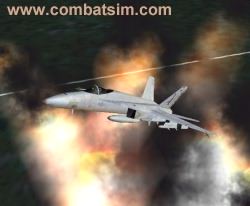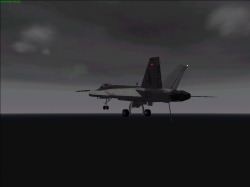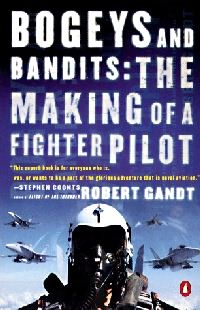|
Books to Whet Your Hornet Appetite
By Bruce Irving January 7th, 2000 |
||||
Jane's F/A-18 will be here in just a couple of weeks. If you are looking forward to this release like I am, you may be seeking ways to prepare yourself to get up close and personal with the Super Hornet and its many systems and weapons. Should you work on your realistic radar skills with Falcon 4? Fly some mud moving missions in F-15? Practice carrier traps at night in Hornet Korea? Set up some naval strike warfare situations in Jane's Fleet Command? Sure - any of these things will help to set the proper mood.
 Or you could go read a book. I'm a big fan of naval aviation and of the Hornet in particular, so I'm looking forward to the immersive and realistic portrayal of carrier and war-at-sea operations in Jane's F/A-18. I'm really interested in what it's like to be a military pilot, and detailed "study sims" like F4, F-15, and F/A-18 get me as close as I can get to this world. But I also like to have a book or two to provide additional background and more of the "what's it really like" stuff I enjoy. So I'd like to recommend three books (two non-fiction, one novel) that any prospective Hornet (real or simulated) pilot would probably find enjoyable and educational. The first and probably best is Air Warriors: The Inside Story of the Making of a Navy Pilot, by Douglas C. Waller (Dell Books, 1998). If you have any interest in naval aviation, you need to read this book. Waller is a national security correspondent for Time magazine and a truly excellent observer and writer. He flew in nearly every aircraft described in the book, from the T-34C "Turbo weenie" to the F/A-18, including dogfights, bomb runs, cat launches, and carrier traps (but not at night). OK, so I'm jealous!
 Waller follows a number of men and women as they progress from pre-flight orientation to primary training in the T-34C (a turboprop trainer), basic jet training in the T-45 Goshawk, and advanced jet training in the Hornet. I've taken a few lessons in Cessnas and Pipers, so I particularly enjoyed Waller's descriptions of the process of learning to do the basic things like landings - and of how hard it is to be consistent. There is a lot to learn about any aircraft that you fly, and the Navy demands that you learn it well, learn it fast, and perform with precision. Chapter 10 is "Pipper to Bull" and it taught me a lot about dive-bombing with minimal avionics (in the T-45 Goshawk trainer). Chapter 11 is called "Dogfighting," and it is 50 pages of the most detailed and fascinating description of a 1v1 dogfight I have ever read. Waller puts you inside the heads of these guys, describing what they see, how they reason, and what they do (again, this is in the T-45 trainer, where basic jet combat skills are learned). This is exciting stuff for a sim pilot! "Carrier quals" are treated with the same blend of accurate detail and personal perspective - this is where precision really pays off, of course, as you fly your tail hook through the ridiculously tiny window that defines a successful trap. Finally, some of the lucky nuggets get to fly the F/A-18 Hornet. In a chapter called "Gucci Warfare" we get to fly along on a ground attack training mission that is also reported in amazing detail. The Hornet is a smart airplane, but it has a LOT of systems to learn, and things happen fast at 500 knots. Helmet fires and finger fires can break out at any time (and the real jet was built without a pause key!). |
 "Air Warriors" is wonderful look inside the world of naval aviation at the pilot's level. While it has plenty of "flying stuff" it also discusses the personal lives of many of the students, as well as the social and practical issues related to women becoming combat pilots. Pilots are people too, and these personal and social issues are also important and interesting. I think anyone with an interest in aviation will enjoy this book. Bogeys and Bandits: The Making of a Fighter Pilot by Robert Gandt (Viking, 1997) This book is a bit more specialized. This book follows one class of eight naval aviators through their advanced jet training in the F/A-18 Hornet in 1995. Because it focuses only on the Hornet, there is more detail on every phase of training for this aircraft - but also more time spent on the issue of women aviators in the first one or two years after the Navy began to allow women pilots in combat roles. Two of the students in the group Gandt followed were women, and one of them happened to have a particularly hard time in several phases of training (despite having already qualified and flown A-4's and other jets in non-combat utility roles - but she took two years off from flying to complete a master's degree, and this really hurt her stick and rudder skills). There is certainly plenty of the "you are there" feel in this book, and plenty of "flying stuff" as well. Gandt is a former Navy pilot himself (A-4), and he writes well, though his descriptions are sometimes not as detailed as those of Waller in "Air Warriors." But there is some good "technical" stuff - I first read this book in 1997 when I was learning GSC's Hornet 3.0, and I found the information on strafing to be especially helpful (roll in at 350 knots, 3000 feet, dive at exactly 15° accelerating to 480 knots in the dive, fire between 1200 and 900 feet, pull to recover). And don't shoot at the wrong target, or your call sign will be "Sniper" (this happened to one student, a 35 year old Marine pilot transitioning to jets after 13 years in helicopters - he had a hard time but finally made it - most of the students are in their mid-twenties). Gandt's descriptions of carrier quals and especially of night quals are really well done. They had me sweating the first time I read this book. He notes that there are only around 2000 pilots in the world qualified to take off and land on aircraft carriers - so it's a pretty exclusive club, and the most difficult "routine" task in aviation. This book enhanced my admiration for the men and women who do this stuff for a living. Finally, I'd like to recommend a book that sadly is out of print. The Sixth Battle by Barrett Tillman (Bantam Books, 1992) is a novel centering on a war in South Africa that draws in carrier battle groups from the US Navy and the Soviet Union. ("Sixth Battle" refers to the fact that there were five major aircraft carrier battles in World War II, and this fictional "sixth battle" has a lot of parallels to those classic battles, especially the Battle of Midway). The descriptions of missile attacks, carrier operations, battles between USN and Soviet fighters (F-14's and F/A-18's vs. Su-27's and MiG-29's), naval strikes against the Soviet carriers - all of these are truly exciting and well written. Tillman is not a naval aviator himself, but he is a pilot and the former editor of "The Hook," the journal of the carrier aviation community. If you can find a copy of this book, get it and read it. It's better than most of Tom Clancy, about on par with some of Larry Bond's books on future wars (Cauldron is my favorite). In addition to being a really good read, it's also a source of mission editor ideas for flight sims and naval sims like Harpoon or Jane's Fleet Command. Note: Air Warriors and Bogeys and Bandits are in print and available from Amazon.com, among other places. The Sixth Battle is out of print - Amazon.com has an out of print search service that may be able to locate a copy for you. For previews of the coming F/A 18 simulations see our Air Combat Previews Index. Join a discussion forum on this article by clicking HERE.
|
|||
|
Copyright © 1997 - 2000 COMBATSIM.COM, INC. All Rights Reserved. Last Updated January 6th, 2000 |
||||
